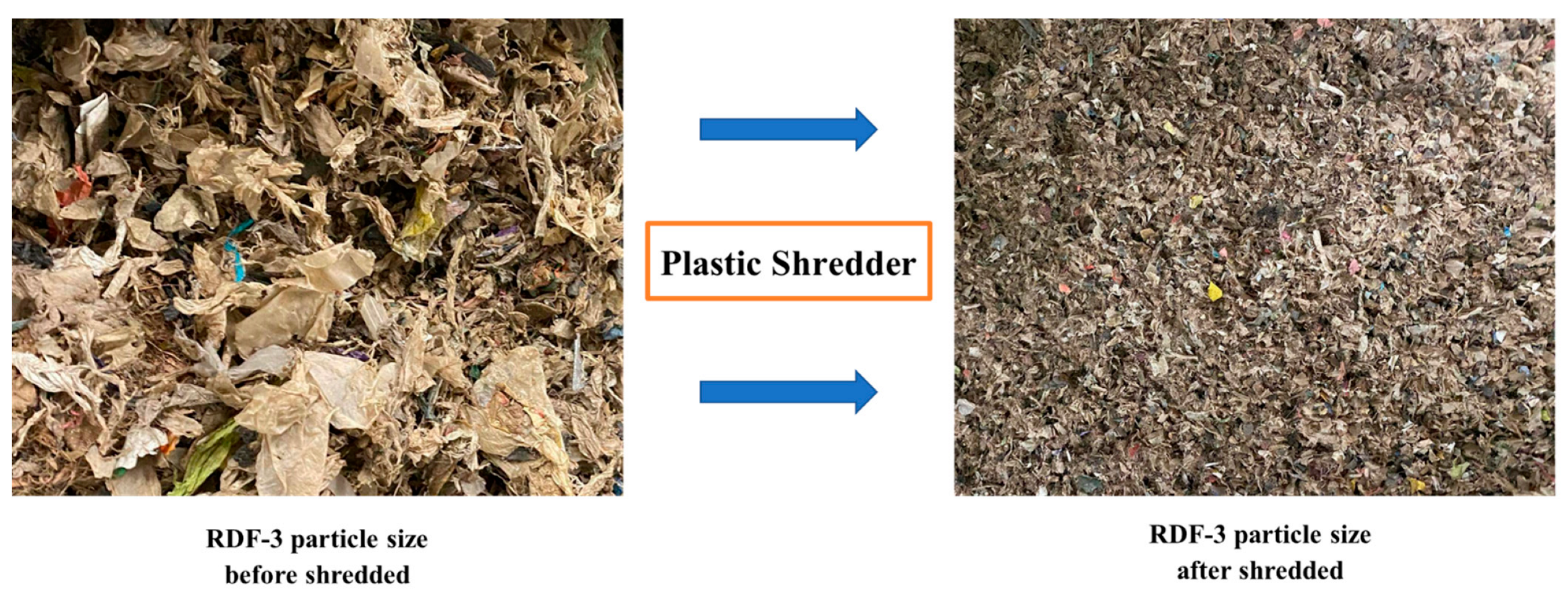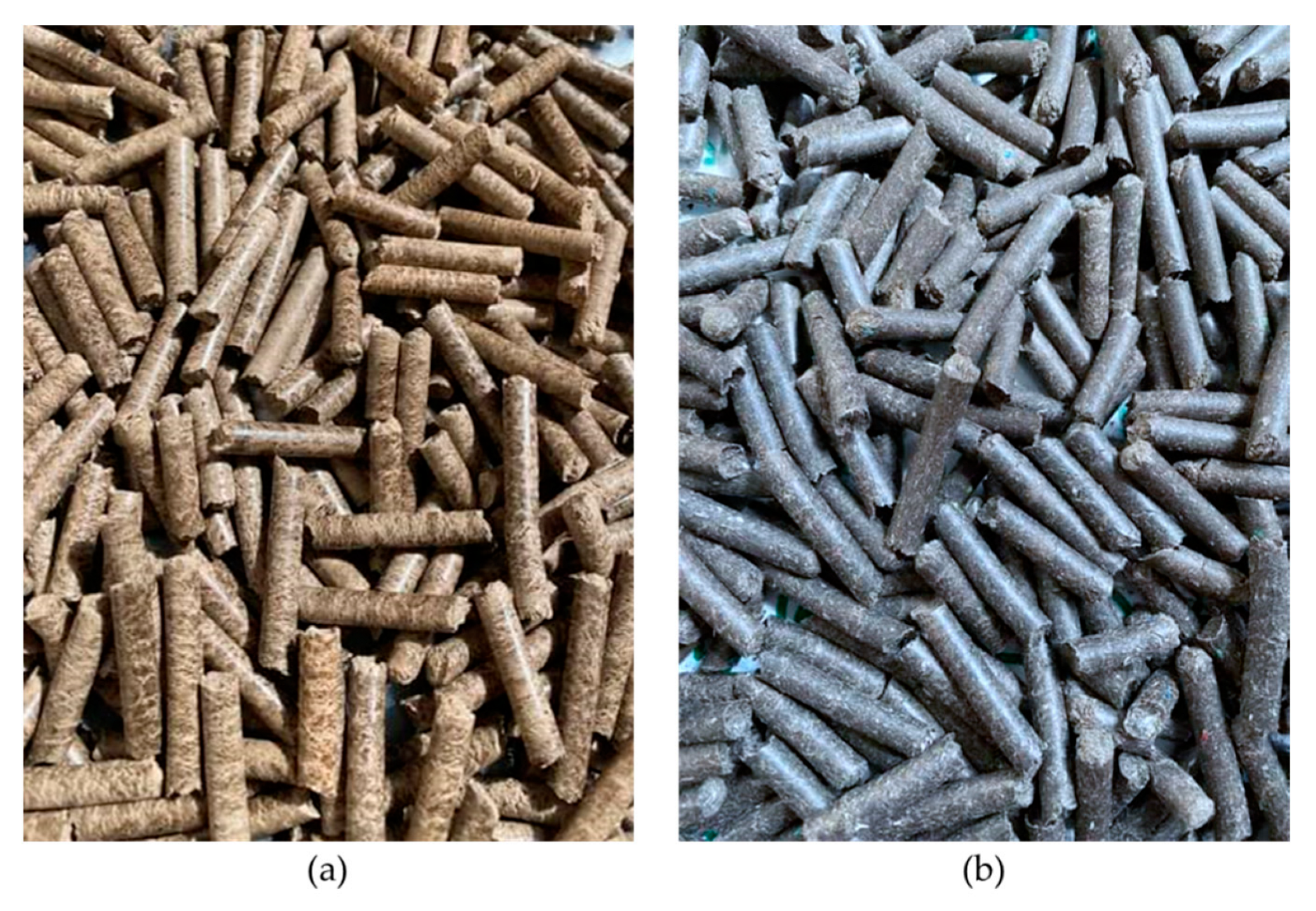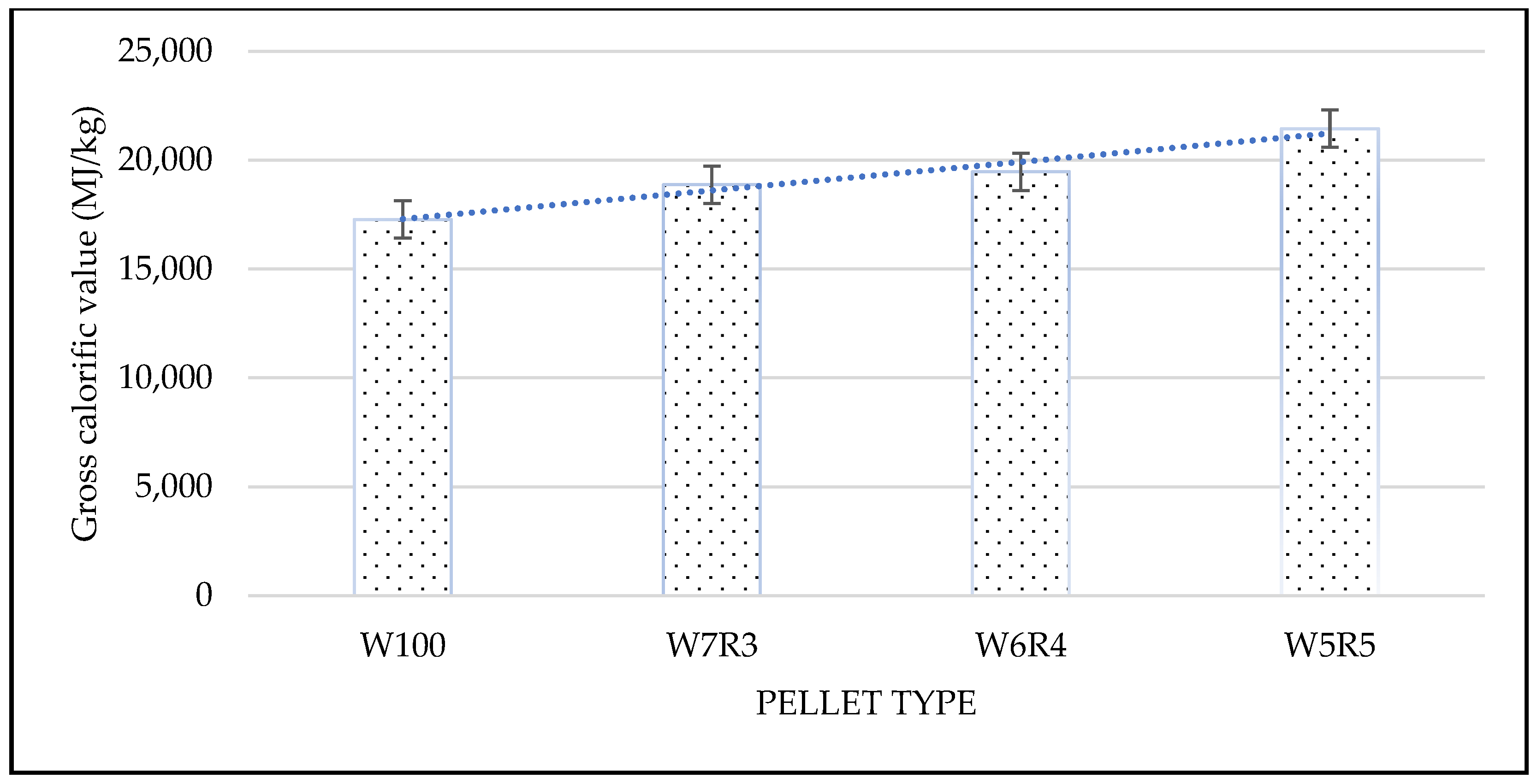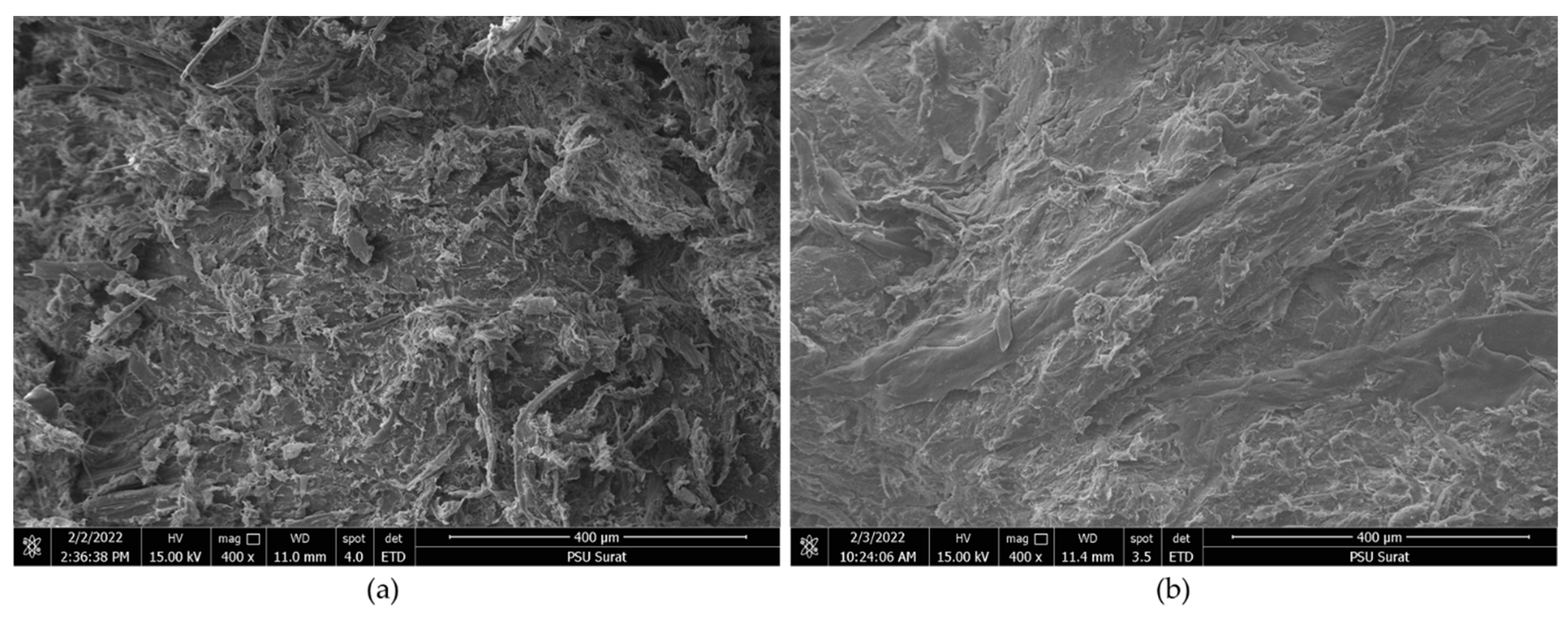Characterization of Mixed Pellets Made from Rubberwood (Hevea brasiliensis) and Refuse-Derived Fuel (RDF) Waste as Pellet Fuel
Abstract
1. Introduction
2. Materials and Methods
2.1. Pelletization and Sample Preparation
2.2. Properties Evaluation of Pellets
Physical Properties of the Samples
2.3. Mechanical Durability of the Samples
2.4. Calorific Value of the Samples
2.5. Ultimate Analysis of the Samples
2.6. Microstructure Evaluation of the Samples
2.7. Data Analysis
3. Results and Discussion
4. Conclusions
Author Contributions
Funding
Conflicts of Interest
References
- Saosee, P.; Sajjakulnukit, B.; Gheewala, S. Life Cycle Assessment of Wood Pellet Production in Thailand. Sustainability 2020, 12, 6996. [Google Scholar] [CrossRef]
- Boukherroub, T.; LeBel, L.; Lemieux, S. An Integrated Wood Pellet Supply Chain Development: Selecting among Feedstock Sources and a Range of Operating Scales. Appl. Energy 2017, 198, 385–400. [Google Scholar] [CrossRef]
- Thrän, D.; Peetz, D.; Schaubach, K.; Mai-Moulin, T.; Junginger, H.M.; Lamers, P.; Visser, L. Global Wood Pellet Industry and Trade Study 2017; IEA Bioenergy Task 40-06-15; IEA Bioenergy: Dublin, Ireland, 2017. [Google Scholar]
- Macko, M.; Mroziński, A. Computer Aided Design of Wood Pellet Machines. Lect. Notes Mech. Eng. 2017, 454–461. [Google Scholar] [CrossRef]
- Shigematsu, A.; Mizoue, N.; Kajisa, T.; Yoshida, S. Importance of rubberwood in wood export of Malaysia and Thailand. New For. 2011, 41, 179–189. [Google Scholar] [CrossRef]
- Thongpat, W.; Taweekun, J.; Maliwan, K. Synthesis and Characterization of Microporous Activated Carbon from Rubberwood by Chemical Activation with KOH. Carbon Lett. 2021, 31, 1079–1088. [Google Scholar] [CrossRef]
- Ratnasingam, J.; Ramasamy, G.; Ioras, F.; Parasuraman, N. Assessment of the carbon footprint of rubberwood sawmilling in peninsular Malaysia: Challenging the green label of the material. BioResources 2017, 12, 3490–3503. [Google Scholar] [CrossRef]
- Kongto, P.; Palamanit, A.; Chaiprapat, S.; Tippayawong, N. Enhancing the Fuel Properties of Rubberwood Biomass by Moving Bed Torrefaction Process for Further Applications. Renew. Energy 2021, 170, 703–713. [Google Scholar] [CrossRef]
- Chotikhun, A.; Kittijaruwattana, J.; Salca, E.-A.; Hiziroglu, S. Selected Physical and Mechanical Properties of Microwave Heat Treated Rubberwood (Hevea Brasiliensis). Appl. Sci. 2020, 10, 6273. [Google Scholar] [CrossRef]
- Rubiyanti, T.; Hidayat, W.; Febryano, I.G.; Bakri, S. Characterization of Rubberwood (Hevea Brasiliensis) Pellets Torrefied with Counter-Flow Multi Baffle (COMB) Reactor. J. Sylva Lestari 2019, 7, 321. [Google Scholar] [CrossRef]
- Hidayat, W.; Rubiyanti, T.; Sulistio, Y.; Iryani, D.A.; Haryanto, A.; Amrul, A.; Yoo, J.; Kim, S.; Lee, S.; Hasanudin, U. Effects of Torrefaction Using COMB Dryer/Pyrolizer on the Properties of Rubberwood (Hevea brasiliensis) and Jabon (Anthocephalus cadamba) Pellets. In Proceedings of the International Conference on Sustainable Biomass (ICSB 2019), Lampung, Malaysia, 15–17 October 2021. [Google Scholar] [CrossRef]
- Ratnasingam, J.; Ramasamy, G.; Wai, L.T.; Senin, A.L.; Muttiah, N. The prospects of rubberwood biomass energy production in Malaysia. BioResources 2015, 10, 2526–2548. [Google Scholar] [CrossRef][Green Version]
- Yang, Y.; Liew, R.K.; Tamothran, A.M.; Foong, S.Y.; Yek, P.N.; Chia, P.W.; Van Tran, T.; Peng, W.; Lam, S.S. Gasification of Refuse-derived Fuel from Municipal Solid Waste for Energy Production: A review. Environ. Chem. Lett. 2021, 19, 2127–2140. [Google Scholar] [CrossRef]
- Cheela, V.R.S.; John, M.; Dubey, B. Quantitative Determination of Energy Potential of Refuse Derived Fuel from the Waste Recovered from Indian Landfill. Sustain. Environ. Res. 2021, 31, 1–9. [Google Scholar] [CrossRef]
- Chiemchaisri, C.; Charnnok, B.; Visvanathan, C. Recovery of Plastic Wastes from Dumpsite as Refuse-Derived Fuel and Its Utilization in Small Gasification System. Bioresour. Technol. 2010, 101, 1522–1527. [Google Scholar] [CrossRef] [PubMed]
- Ramos Casado, R.; Arenales Rivera, J.; Borjabad García, E.; Escalada Cuadrado, R.; Fernández Llorente, M.; Bados Sevillano, R.; Pascual Delgado, A. Classification and Characterisation of SRF Produced from Different Flows of Processed MSW in the Navarra Region and Its Co-Combustion Performance with Olive Tree Pruning Residues. Waste Manag. 2016, 47, 206–216. [Google Scholar] [CrossRef] [PubMed]
- Kamperidou, V.; Lykidis, C.; Barmpoutis, P. Assessment of the Thermal Characteristics of Pellets Made of Agricultural Crop Residues Mixed with Wood. BioResources 2017, 12, 9263–9272. [Google Scholar] [CrossRef]
- Lombardi, L.; Carnevale, E.; Corti, A. A Review of Technologies and Performances of Thermal Treatment Systems for Energy Recovery from Waste. Waste Manag. 2015, 37, 26–44. [Google Scholar] [CrossRef]
- Iqbal, M.; Nadeem, A.; Butt, M. Refused Derived Fuel Pellets from Municipal Solid Waste and Rice Husk. Bangladesh J. Sci. Ind. Res. 2019, 54, 329–338. [Google Scholar] [CrossRef]
- Saputro, H.; Liana, D.N.; Firdaus, A.; Mahmudin, M.; Evan, B.; Karsa, B.S.; Perdana, V.L.; Wijayanto, D.S.; Bugis, H.; Fitriana, L. Preliminary Study of Pellets Refuse Derived Fuel (RDF-5) Based on Durian Waste for Feedstock in Fast Pyrolysis. IOP Conf. Ser. Mater. Sci. Eng. 2018, 434, 012184. [Google Scholar] [CrossRef]
- Cui, X.; Yang, J.; Wang, Z.; Shi, X. Better Use of Bioenergy: A Critical Review of Co-Pelletizing for Biofuel Manufacturing. Carbon Capture Sci. Technol. 2021, 1, 100005. [Google Scholar] [CrossRef]
- Win, M.M.; Asari, M.; Hayakawa, R.; Hosoda, H.; Yano, J.; Sakai, S.-I. Gas and Tar Generation Behavior during Flash Pyrolysis of Wood Pellet and Plastic. J. Mater. Cycles Waste Manag. 2019, 22, 547–555. [Google Scholar] [CrossRef]
- Al-Salem, S.M.; Antelava, A.; Constantinou, A.; Manos, G.; Dutta, A. A Review on Thermal and Catalytic Pyrolysis of Plastic Solid Waste (PSW). J. Environ. Manag. 2017, 197, 177–198. [Google Scholar] [CrossRef] [PubMed]
- Zhang, X.; Lei, H.; Chen, S.; Wu, J. Catalytic Co-Pyrolysis of Lignocellulosic Biomass with Polymers: A Critical Review. Green Chem. 2016, 18, 4145–4169. [Google Scholar] [CrossRef]
- Grieco, E.M.; Baldi, G. Pyrolysis of Polyethylene Mixed with Paper and Wood: Interaction Effects on Tar, Char and Gas Yields. Waste Manag. 2012, 32, 833–839. [Google Scholar] [CrossRef] [PubMed]
- Kumagai, S.; Fujita, K.; Kameda, T.; Yoshioka, T. Interactions of Beech Wood–Polyethylene Mixtures during Co-Pyrolysis. J. Anal. Appl. Pyrolysis 2016, 122, 531–540. [Google Scholar] [CrossRef]
- Kerdsuwan, S.; Meenaroch, P.; Chalermcharoenrat, T. The Novel Design and Manufacturing Technology of Densified RDF from Reclaimed Landfill without a Mixing Binding Agent Using a Hydraulic Hot Pressing Machine. MATEC Web Conf. 2016, 70, 11003. [Google Scholar] [CrossRef]
- Donahue, C.J.; Rais, E.A. Proximate Analysis of Coal. J. Chem. Educ. 2009, 86, 222. [Google Scholar] [CrossRef]
- Ungureanu, N.; Vladut, V.; Voicu, G.; Dinca, M.-N.; Zabava, B.-S. Influence of Biomass Moisture Content on Pellet Properties-Review. Eng. Rural Dev. 2018, 17, 1876–1883. [Google Scholar] [CrossRef]
- Jewiarz, M.; Mudryk, K.; Wróbel, M.; Frączek, J.; Dziedzic, K. Parameters Affecting RDF-Based Pellet Quality. Energies 2020, 13, 910. [Google Scholar] [CrossRef]
- Alhindawi, I.; Jimenez-Bescos, C. Assessing the Performance Gap of Climate Change on Buildings Design Analytical Stages Using Future Weather Projections. Environ. Clim. Technol. 2020, 24, 119–134. [Google Scholar] [CrossRef]
- Rezaei, H.; Yazdan Panah, F.; Lim, C.J.; Sokhansanj, S. Pelletization of Refuse-Derived Fuel with Varying Compositions of Plastic, Paper, Organic and Wood. Sustainability 2020, 12, 4645. [Google Scholar] [CrossRef]
- García, R.; González-Vázquez, M.P.; Rubiera, F.; Pevida, C.; Gil, M.V. Co-Pelletization of Pine Sawdust and Refused Derived Fuel (RDF) to High-Quality Waste-Derived Pellets. J. Clean. Prod. 2021, 328, 129635. [Google Scholar] [CrossRef]
- Junfeng, L.; Runqing, H. Sustainable Biomass Production for Energy in China. Biomass Bioenergy 2003, 25, 483–499. [Google Scholar] [CrossRef]
- Halim, S.A.; Swithenbank, J. Characterisation of Malaysian Wood Pellets and Rubberwood Using Slow Pyrolysis and Microwave Technology. J. Anal. Appl. Pyrolysis 2016, 122, 64–75. [Google Scholar] [CrossRef]






| Sample Type | Rubberwood (%w/w) | RDF (%w/w) |
|---|---|---|
| W100 | 100 | - |
| W7R3 | 70 | 30 |
| W6R4 | 60 | 40 |
| W5R5 | 50 | 50 |
| Sample | Diameter | Length | Density | Color | |||
|---|---|---|---|---|---|---|---|
| Type | (mm) | (mm) | (g/cm3) | ||||
| Mean | Mean | Mean | |||||
| W100 | 6.11 b | ±(0.02) | 36.27 c | ±(0.33) | 1.288 a | ±(0.011) | brown |
| W7R3 | 6.19 a | ±(0.01) | 43.40 a | ±(0.29) | 1.121 d | ±(0.003) | black |
| W6R4 | 6.13 b | ±(0.05) | 41.49 b | ±(1.05) | 1.175 c | ±(0.022) | black |
| W5R5 | 6.21 a | ±(0.03) | 41.64 b | ±(0.57) | 1.234 b | ±(0.018) | black |
| Sample | Mechanical | Calorific Value (MJ/kg) | ||
|---|---|---|---|---|
| Type | Durability (%) | |||
| Mean | Mean | |||
| W100 | 98.39 b | ±(0.32) | 17,277 d | ±(60) |
| W7R3 | 98.27 b | ±(0.09) | 18,866 c | ±(230) |
| W6R4 | 98.85 a | ±(0.07) | 19,461 b | ±(83) |
| W5R5 | 99.07 a | ±(0.09) | 21,445 a | ±(520) |
| Sample Type | Ultimate Analysis | |||||||||
|---|---|---|---|---|---|---|---|---|---|---|
| C | H | N | S | Cl | ||||||
| Mean (%) | Mean (%) | Mean (%) | Mean (%) | Mean (%) | ||||||
| W100 | 47.81 b | ±(0.54) | 7.74 b | ±(1.27) | 0.28 b | ±(0.05) | 0.57 d | ±(0.02) | 0.017 c | ±(0.002) |
| W7R3 | 47.59 b | ±(0.36) | 10.61 a | ±(1.19) | 0.47 b | ±(0.05) | 0.90 c | ±(0.02) | 0.093 b | ±(0.005) |
| W6R4 | 47.87 b | ±(0.22) | 11.76 a | ±(0.78) | 0.47 b | ±(0.20) | 1.45 a | ±(0.13) | 0.118 a | ±(0.003) |
| W5R5 | 50.78 a | ±(1.72) | 10.35 a | ±(0.78) | 0.69 a | ±(0.03) | 1.06 b | ±(0.08) | 0.124 a | ±(0.002) |
| Sample Type | Proximate Analysis | |||||||
|---|---|---|---|---|---|---|---|---|
| MC | VM | Ash | FC | |||||
| Mean (%) | Mean (%) | Mean (%) | Mean (%) | |||||
| W100 | 9.61 c | ±(0.21) | 72.03 a | ±(0.03) | 2.50 d | ±(0.13) | 15.85 a | ±(0.22) |
| W7R3 | 11.17 a | ±(0.44) | 65.69 c | ±(0.43) | 9.90 c | ±(0.09) | 13.24 b | ±(0.47) |
| W6R4 | 10.49 b | ±(0.10) | 65.38 c | ±(0.10) | 11.87 b | ±(0.23) | 12.26 b | ±(0.32) |
| W5R5 | 5.50 d | ±(0.41) | 68.24 b | ±(0.76) | 13.78 a | ±(0.18) | 12.48 b | ±(0.84) |
Publisher’s Note: MDPI stays neutral with regard to jurisdictional claims in published maps and institutional affiliations. |
© 2022 by the authors. Licensee MDPI, Basel, Switzerland. This article is an open access article distributed under the terms and conditions of the Creative Commons Attribution (CC BY) license (https://creativecommons.org/licenses/by/4.0/).
Share and Cite
Laosena, R.; Palamanit, A.; Luengchavanon, M.; Kittijaruwattana, J.; Nakason, C.; Lee, S.H.; Chotikhun, A. Characterization of Mixed Pellets Made from Rubberwood (Hevea brasiliensis) and Refuse-Derived Fuel (RDF) Waste as Pellet Fuel. Materials 2022, 15, 3093. https://doi.org/10.3390/ma15093093
Laosena R, Palamanit A, Luengchavanon M, Kittijaruwattana J, Nakason C, Lee SH, Chotikhun A. Characterization of Mixed Pellets Made from Rubberwood (Hevea brasiliensis) and Refuse-Derived Fuel (RDF) Waste as Pellet Fuel. Materials. 2022; 15(9):3093. https://doi.org/10.3390/ma15093093
Chicago/Turabian StyleLaosena, Rattikal, Arkom Palamanit, Montri Luengchavanon, Jitralada Kittijaruwattana, Charoen Nakason, Seng Hua Lee, and Aujchariya Chotikhun. 2022. "Characterization of Mixed Pellets Made from Rubberwood (Hevea brasiliensis) and Refuse-Derived Fuel (RDF) Waste as Pellet Fuel" Materials 15, no. 9: 3093. https://doi.org/10.3390/ma15093093
APA StyleLaosena, R., Palamanit, A., Luengchavanon, M., Kittijaruwattana, J., Nakason, C., Lee, S. H., & Chotikhun, A. (2022). Characterization of Mixed Pellets Made from Rubberwood (Hevea brasiliensis) and Refuse-Derived Fuel (RDF) Waste as Pellet Fuel. Materials, 15(9), 3093. https://doi.org/10.3390/ma15093093











